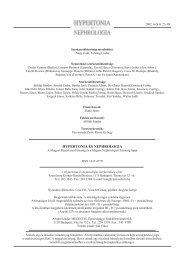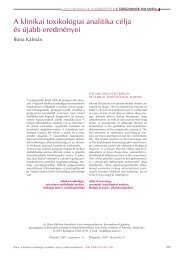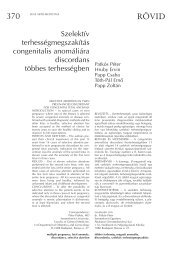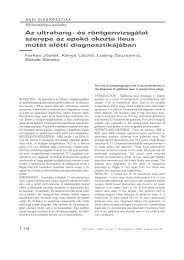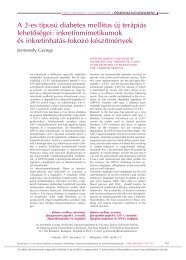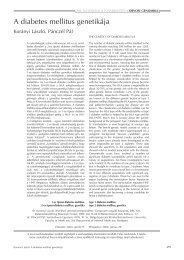HYPERTONIA ÉS NEPHROLOGIA - eLitMed.hu
HYPERTONIA ÉS NEPHROLOGIA - eLitMed.hu
HYPERTONIA ÉS NEPHROLOGIA - eLitMed.hu
Create successful ePaper yourself
Turn your PDF publications into a flip-book with our unique Google optimized e-Paper software.
ÖSSZEFOGLALÓ KÖZLEMÉNYEK / REVIEW ARTICLES<br />
Novel insights into uremic vascular calcifications<br />
Markus Ketteler, MD<br />
Department of Nephrology and Clinical Immunology. University Hospital Aachen, Germany<br />
<strong>HYPERTONIA</strong> <strong>ÉS</strong> <strong>NEPHROLOGIA</strong> 2005; 9 (1):14–18.<br />
ABSTRACT In the recent past, it has become increasingly clear that extracellular calcium<br />
and phosphate homeostasis is a tightly regulated process. Even the physiological serum<br />
concentrations of calcium and phosphate are several orders of magnitude above their<br />
solubility product in an aqueous solution. Although pH, body temperature and the ionic<br />
strength of serum compensates largely for this difference, serum remains a “metastable”<br />
solution concerning calcium and phosphate precipitation. Therefore, precipitation<br />
inhibitory mechanisms must be operative to prevent extraosseous calcification. In this<br />
context, a number of local and systemic calcification inhibitors could be identified in<br />
recent years, and deficiencies and dysregulations of such factors, respectively, may<br />
contribute to morbidity and even mortality in patient populations. Further,<br />
hyperphosphatemia may not just passively contribute to an increased calcium and<br />
phosphate ion product, but may induce an active process of osteogenic dedifferentiation<br />
in vascular smooth muscle cells. Extensive extraosseous calcifications occur with high<br />
prevalence in patients with end-stage renal disease (ESRD), and especially vascular<br />
manifestations are clearly associated with cardiovascular events and decreased survival<br />
in this particular patient group. In the context of the accelerated nature of atherosclerosis<br />
observed in dialysis patients, novel pathomechanisms involved in uremic vascular<br />
calcification will be discussed in this brief overview.<br />
Key words: vascular calcification, end stage renal disease, hyperphosphatemia, Matrix<br />
Gla Protein, Fetuin-A<br />
Corresponding author:<br />
PD Dr. med. Markus Ketteler<br />
Department of Nephrology and Clinical<br />
Immunology<br />
Universtity Hospital Aachen<br />
Pauwelsstr. 30<br />
D-52057 Aachen<br />
Germany<br />
Phone: +49-241-8089530<br />
Fax: +49-241-8082446<br />
e-mail: mketteler@ukaachen.de<br />
Content<br />
Introduction<br />
Intimal versus medial calcifications<br />
The role of hyperphosphatemia<br />
Calcification inhibitors<br />
Matrix Gla Protein (MGP)<br />
Fetuin-A (2-Heremans Schmid<br />
glycoprotein, AHSG)<br />
Conclusion<br />
References<br />
INTRODUCTION<br />
Cardiovascular mortality is dramatically<br />
increased in uremic patients.<br />
Registry data demonstrated that this is<br />
particularly true for young ESRD patients:<br />
30-year-old dialysis patients<br />
suffer from an up to 500-fold elevated<br />
mortality risk when compared to an<br />
age-matched normal population and<br />
have an average life expectancy comparable<br />
to 85-year-old non-dialysis<br />
subjects (1). Accelerated calcifying<br />
atherosclerosis and valvular calcifications<br />
are hallmarks of cardiovascular<br />
disease in the dialysis population, and<br />
the magnitude of vessel calcification<br />
was recently identified as an independent<br />
risk factor of cardiovascular death<br />
in dialysis patients (2, 3). Typical metabolic<br />
disturbances in uremia including<br />
hyperphosphatemia, an increased<br />
calcium x phosphate product, hyperparathyroidism,<br />
and possibly an increased<br />
calcium intake are independent<br />
predictors of cardiovascular morbidity<br />
and mortality in this population<br />
(4-7).<br />
By using EBCT, Goodman et al.<br />
demonstrated in young dialysis patients<br />
that coronary artery calcifications<br />
(see example in figure 1) are al-



